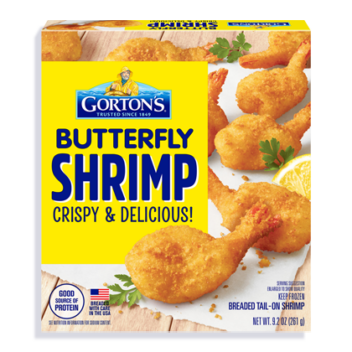Since 1849, Gloucester Massachusetts has been the home to a company that is today known as Gorton’s. At one time they were vertically integrated with their own fleet of fishing schooners, maintenance infrastructure, storage facilities and sales staff – an island unto itself in one of the most storied fishing ports in history.
Their fleet is gone, and so is the local fish, but Gorton’s has remained strong and is still a major employer here in Gloucester. Anyone who lives near downtown knows that familiar smell of frying fish wafting from their historic dockside plant. Millions of customers nationwide still “trust the Gorton’s Fisherman” for their array of seafood products, which has expanded beyond their standard fish sticks.
Here in the home port however, I’m not sure sales are all that high. However when new products are announced many of us in town go to try them out. Not too long ago Gorton’s brought back an old favorite: haddock. Both in fish sticks and in larger breaded fillet portions.
Gorton’s has always prided itself on sourcing fish from healthy stocks, but they have recently gone the certified route. The company has gone to great expense for a sustainable “eco-label” on their products.
I’ve tried these haddock fillets when they first came out. My father, like many former commercial fishermen, works for Gorton’s and the company allows employees to purchase new or special products at cost. Back then I didn’t have the website yet so I decided to take another look, especially now with the box sporting an eco-label. So what do you think…should this “Glosta” boy still trust the Gorton’s Fisherman?
The Gorton’s Haddock Packaging
It’s hard to miss the Gorton’s products in a frozen food section. Most of their products are bright yellow – just like the unsullied oilskins of Gorton’s Fisherman. Their new eco-label is located on the back of the box.
The Gorton’s Haddock Product
If you are familiar with fish sticks – or fish fingers depending where you are from – then think of these portions are larger fish sticks with a higher fish to breading ratio. A box contains a little over 14 ounces which is about 4-5 thin breaded fillets.
Preparing Gorton’s Haddock
I just followed what the box told me to do: 12 minutes per side at 425F or until golden brown. When finished some of the fillets stuck to the foil on my baking sheet, this has happened to me with several Gorton’s products, but in this case I was able to remove the fillets without damage. Cutting into a piece shows that it is not minced but actual whole fish as I was expecting.
The Verdict on Gorton’s Haddock Fillets
My feeling is that if you are already a fan of fish sticks, then you will really enjoy these. I had mine with lemon and they were not bad. An idea that came to mind was to get some bulkie rolls and make some tartar sauce, add a slice a cheese, some lettuce, tomato and red onion and you got budget-friendly fish sandwiches for a weekday-night dinner.
However if you don’t like fish sticks this gorproduct may not convert you. It has the qualities of a fish stick, including the taste of the breading, but a step up from the usual Alaskan pollock in terms of flavor, flakiness and quality of fish. This makes a big difference to me, haddock just makes a better fish fillet. I don’t consider myself a fish stick fan, but I wouldn’t mind having a couple boxes of these in my freezer for a quick dinner or snack.
This article was originally published by buyingseafood

